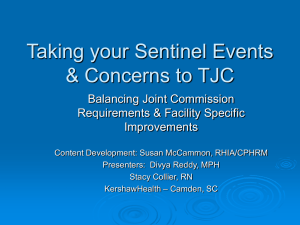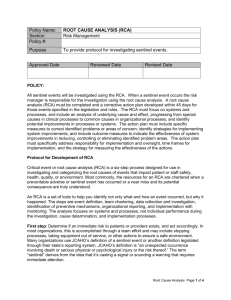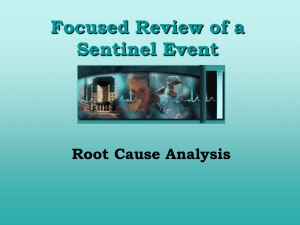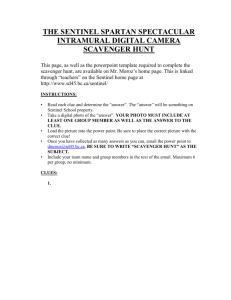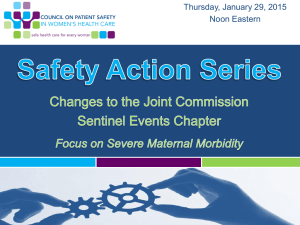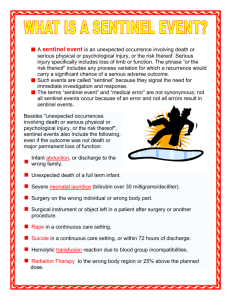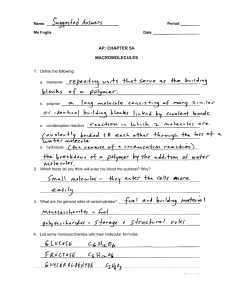Event Reporting, Disclosure, Sentinel Events & Mock RCA – Grand
advertisement
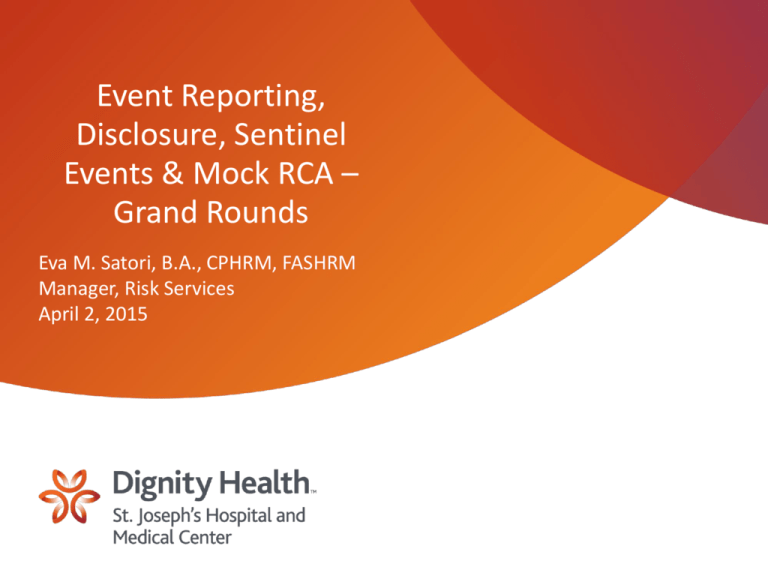
Event Reporting, Disclosure, Sentinel Events & Mock RCA – Grand Rounds Eva M. Satori, B.A., CPHRM, FASHRM Manager, Risk Services April 2, 2015 Objectives • What Events should be reported in online Event Reporting System (ERS) • Definition of Sentinel Events • Disclosure of Adverse Events • Definition Root Cause Analysis (RCA) • Mock RCA 2 Definitions • Event (incident, occurrence, notification): – Any unanticipated event that is not consistent with the routine care of a particular patient and/or the routine operation of the facility. An event may be a potential or actual adverse event that involves a patient, guest, employee, volunteer, student or physician. • Sentinel Event: – An unexpected event involving death or serious physical injury or psychological injury or the risk thereof. Serious injury includes loss of limb or function. The phrase “or risk thereof” includes any process variation for which the recurrence would carry significant chance of serious adverse outcome. • Disclosure: – Information regarding the results of a diagnostic test, medical treatment or surgical intervention communicated to the patient, family and/or surrogate. • Root Cause Analysis (RCA): – Is a process intended to help organizations delve deeper into processes (not people). 3 Event Reporting 4 Event Reporting • An event/incident is any unanticipated event or any potential event that is not consistent with the routine care of a particular patient and/or routine operation of the facility. – Be timely – Be factual – Provide details – You may submit anonymously but it is always best if your name is provided for follow up – Inform Attending MD, Program Directors or Chiefs – Safe Harbor provision – report event within 48 hours in which employee involved. 5 Event Reporting 6 What happens to Event Reports? • Categorized and Routed to the involved Department/Director/Manager/Medical Staff • Investigated and reviewed • Improvement activities and follow up plans • Serious events are quickly escalated to leadership for review and consideration of RCA. 7 Examples of Events to be report in Event Reporting System (ERS) • Missed diagnosis or misdiagnosis • Procedure or test done on wrong patient • Reactions/complications to a medical test • Patient death or serious injury associated with unsafe administration of blood products • Hospital incurred trauma, injury or infection • Patient or guest suicide or suicide attempt • Death or permanent loss of function from a hospital acquired injury • See “Think Pink handout” examples for further examples. 8 TOTAL SJHMC ERS FY13 & FY14 9 SJHMC FY14 TOP 10 CATEGORIES Mislabeled specimen 25 13 73 Skin/Wound: HAPU 20 Unexpected clin event Accidental fall 62 Medication/IV: Infilitration/extravasation 100 12 11 Equipment/Device: Disconnection/dislodged Fall: Anticipated physiological AMA 79 Skin/Wound: Skin tear/laceration 73 Equipment/Device: malfunction 10 SJHMC 1st QUARTER FY15 TOP 10 CATEGORIES 40 47 180 Other: unexpected clinical event 54 Skin/Wound: HAPU Fall: Accidental fall Other: AMA 54 Medication/IV: other Other: Elopement 83 58 Complaint: Service Perinatal: vaginal Tests/Tx: mislabeled specimens Tests/Tx: delays 80 95 92 11 Sentinel Events 12 What is a Sentinel Event? • The Joint Commission (TJC) adopted a formal Sentinel Event Policy in 1996 to help hospitals that experience serious adverse events, improve safety and learn from those sentinel events. • Definition of Sentinel Event: – Death – Permanent Harm – Severe Temporary Harm (critical, potentially life-threatening harm lasting for a limited time with no permanent residual, but requires transfer to higher level of care/monitoring for a prolonged period of time, transfer to higher level of care for a life-threatening condition, or additional major surgery, procedure, or treatment to resolve the condition.) 13 What is a Sentinel Event? (cont) • An event is also considered sentinel if it is one of the following: – Suicide of any patient receiving care, treatment, and services in a staffed around-the-clock care setting or within 72 hours of discharge, including from a hospital’s ED – Unanticipated death of a full-term infant – Discharge of an infant to the wrong family – Abduction of any patient receiving care, treatment, and services – Any elopement (that is, unauthorized departure) of a patient from a staffed around-the-clock care setting (including the ED), leading to a death, permanent harm, or severe temporary harm to the patient – Hemolytic transfusion reaction involving administration of blood or blood products having major blood group incompatibilities (ABO, Rh, other blood groups) 14 What is a Sentinel Event? (cont) – Rape, assault (leading to death, permanent harm, or severe temporary harm), or homicide of a staff member, licensed independent practitioner, guest, or vendor while on site at the hospital – Invasive procedure, including surgery, on the wrong patient, at the wrong site, or that is the wrong (unintended) procedure – Unintended retention of a foreign object in a patient after an invasive procedure, including surgery – Severe neonatal hyperbilirubenemia (bilirubin >30 milligrams/deciliter) – Prolonged fluroscopy with cumulative dose >1,500 rads to a single field or any delivery of radiotherapy to the wrong body region or >25% above the planned radiotherapy dose – Fire, flame, or unanticipated smoke, heat or flashes occurring during an episode of patient care – Any intrapartum (related to the birth process) maternal death or severe maternal morbidity 15 Disclosure 16 Disclosure • Patients and their families will be informed about outcomes of treatment, including those that differ significantly from anticipated outcomes. • The attending physician will lead the disclosure discussion. A representative from the hospital/Nursing, and Risk Manager will be present. • Provide a factual explanation of the event and the impact on the patient’s treatment. • A commitment to investigate the event in order to prevent like occurrences. • Resources available to support and comfort the patient, family and/or surrogate. • An apology or other expression of sympathy. 17 Disclosure – documentation in medical record • Documentation in the medical record, should be completed by the physician or other designated individual participating in the disclosure and should contain: – A full description of facts of the event, without conjecture as to the cause or attribution of fault/blame. – Detailed disclosure discussions with the patient, family and/or surrogate. – Identity of any interpreter used during the disclosure. – Any follow-up discussions with the patient, family and/or surrogate. – Complete an event report (if one not already completed). Do not refer to the event report in the patient’s medical record. 18 May I apologize? • Arizona Apology Law ARS 12-2605 (2005) – In any civil action that is brought against a health care provider…any statement…expression apology…made by a health care provider…to the patient…that relates to discomfort, pain, suffering, injury, or death of the patient as a result of the unanticipated outcome of medical care is inadmissible as evidence of an admission of liability. 19 Root Cause Analysis (RCA) 20 Root Cause Analysis (RCA) • Per The Joint Commission (TJC) and St. Joseph’s policy, an RCA is to be completed within 45 days of the event. • Is a process for identifying the basic and causal factor(s) that underlying variation in performance, including the occurrence or possible occurrence of a sentinel event. Focuses primarily on systems and processes, not individual performance. Addresses the appropriate elements from TJC “Minimum Scope of Review of RCA”. Set ground-rules: • • • • Safe, blame-free, protected • Structured retrospective analysis of events • Multidisciplinary • Focus on systems and processes, not individual performance • Identify and implement improvement actions to prevent recurrence 21 Root Cause Analysis (RCA) (cont) • The Joint Commission (TJC) expects hospitals to identify and respond appropriate to all sentinel events: • A formalized team response that stabilizes the patient, discloses the event to the patient and family, and provides support for the family as well as staff involved. • Notification of hospital leadership. • Immediate investigation. • Completion of a comprehensive systematic analysis for identifying the causal and contributory factors. • Corrective actions. • Timeline for implementation of corrective actions. • Systemic improvement. 22 RCA process • Start the investigation • Gather data (e.g. staff involved, create a timeline) • Analyze the data • Identify root causes – A determination of the human and other factors most directly associated with the sentinel event and the process(es) and systems related to its occurrence; – Analysis of the underlying systems and processes through a series of “WHY?” questions to determine where redesign might reduce risk; – Identification of risk points and their potential contributions to this type of event • Create recommendations • Complete investigation and follow up on results 23 RCA Action Plan • RCA action plan addressing the identified root causes, will identify the strategies than an organization intends to implement to reduce the risk of similar events occurring in the future. An appropriate action plan should demonstrate the following: – Identify changes that can be implemented to reduce risk, or formulates a rationale for not undertaking such changes. – Address responsibility for implementation, oversight, pilot testing as appropriate, timelines, and strategies for measuring the effectiveness of the actions. 24 RCA – Common Pitfalls and Strategies to Avoid them • Common Pitfalls • Guiding Principles – Insufficient Organizational Support – Embrace Organizational Learning – Reliance on the “Old View” – Address Root Causes – Hindsight Bias – Focus on “Work as Done” – Emphasis on “Work as Written” – See Perspective of Staff – Failure to Reach True Root Causes – Get into the Mindset – Root Causes Unaddressed – Delve Deeply – Insufficient Follow-Up, monitoring – Develop Leading Indicators 25 MOCK RCA • Patient RW – 64 YO male with new onset seizure-like activity with right hemiplegia, altered mental status – After consulting neurology, decided to get MRI with LP; MRI performed under general anesthesia due to deteriorating mental status – MRI results inconclusive, so LP performed while patient still under general anesthesia – Neurology reviews the MRI and adds additional recommendations which are text to the Medicine intern – Next AM, patient RW is told that the LP studies looked normal. He hadn’t realized the LP was even performed and is angry about this fact. – Neurology recommends additional LP to complete studies which weren’t done. 26 MOCK RCA (cont) • Was there an error in RW’s care? – How would you classify the error(s)? • Was there an adverse event? – If so, was it preventable? • Should an Event Report be completed? – If so, by whom? 27 Most Frequently Identified Root Causes of Sentinel Events Reviewed by The Joint Commission by Year The majority of events have multiple root causes (Please refer to subcategories listed on slides 5-7) 2013 (N=887) Jan to Jun 2014 (N=394) Human Factors 614 Human Factors 635 Human Factors 290 Leadership Communication 557 532 Communication Leadership 563 547 Leadership Communication 269 248 Assessment 482 Assessment 505 Assessment 208 Information Management 203 Information Management 155 Physical Environment 53 Physical Environment 150 Physical Environment 138 Care Planning 38 Continuum of Care 95 Care Planning 103 Information Management 36 Operative Care 93 Continuum of Care 97 Continuum of Care 33 Medication Use 91 Medication Use 77 Operative Care 29 Care Planning 81 Operative Care 76 Health information technologyrelated 27 The reporting of most sentinel events to The Joint Commission is voluntary and represents only a small proportion of actual events. Therefore, these root cause data are not an epidemiologic data set and no conclusions should be drawn about the actual relative frequency of root causes or trends in root causes over time. Office of Quality Monitoring 28 © Copyright, The Joint Commission 2012 (N=901) Resources • Think Pink handout Sample Reportable Events (revised 11/18/14) • AZ Service Area Policy Event Reporting Policy 2.011/10025.1 (effective 9/1/14) • Dignity Health Patient Safety Event Reporting and Management Policy 100.5.006 (effective 6/26/14) • St. Joseph’s Sentinel Event Identification/Investigation Policy 10027 (effective 12/27/06; last reviewed 8/1/12) • Comprehensive Accreditation Manual for Hospitals (CAMH) (1/2015) • Dignity Health Patient Safety Disclosure of Unanticipated or Adverse Outcome to Patients/Families (6/26/14) • St. Joseph’s Medical Staff Disclosure Policy (10/17/14) • Getting the Most out of RCAs (ECRI 2/10/15) • Root Cause Analysis: How Incident Reports Lead to Improvements & Mock RCA (Matt Russell, M.D., Glenn Rosenbluth, M.D. UCSF 2014) • What I Learned About Adverse Events from Captain Sully: It’s Not What You Think (Marjorie Podraza Stiegler, M.D. JAMA 1/27/15) 29 Thank You! Eva M. Satori, B.A., CPHRM, FASHRM Manager Risk Services 602.406.6937 office 602.746.4069 pager 818.207.6535 cell
